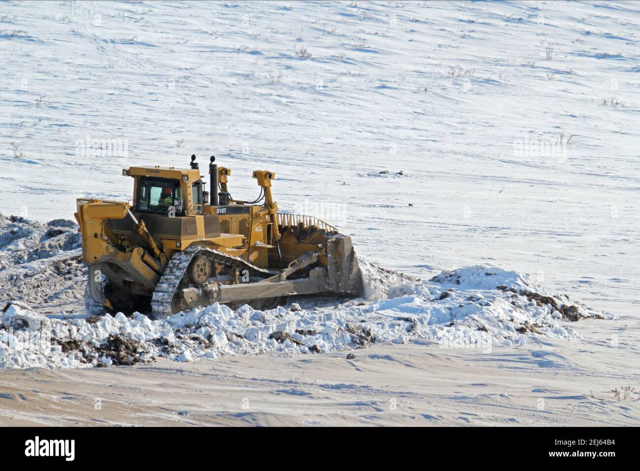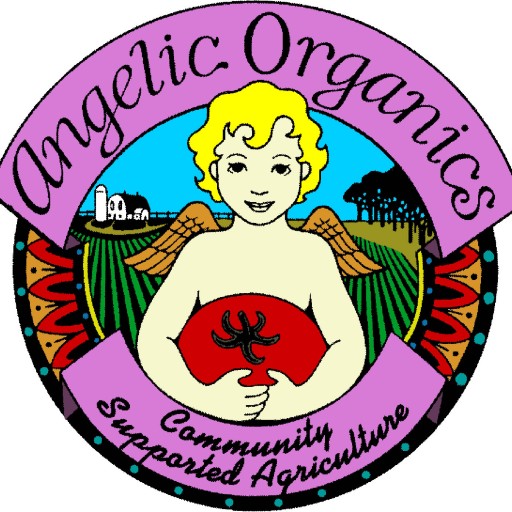Farmer John Writes: Freezing in the Heat of Summer
Harvest Week 18, October 31st – November 5th, 2022
If You Customized Your Share with Spinach this Week
Because it’s time consuming for our crew to remove all the weeds from your spinach, you might get extra weeds in your spinach this week. Also, you may receive a few frost-damaged leaves. Please join our farm team in extracting weeds and damaged leaves from your spinach. (Having gone through a couple of frosts, the spinach should be extra delicious this week.)

our tractors want to work
Shoveled Out a Horse
My mom talked about a winter in the 30’s, when she lived one township west of here. The township had no snow removal equipment. Neighbors were expected to shovel the snow off the road. It seemed all it did was snow that winter, with neighbors shoveling and shoveling. My mom was riding her horse Daisy home from school one afternoon and got her horse stuck in the snow. A neighbor shoveled her and her horse to freedom.
A fellow was at Angelic Organics this fall. He hadn’t been here since 1976.
“I lost my car here,” he said.
“Oh, that was you?” I asked.
“I went home from the barn party with some friends. I came back a few days later to get my car. We couldn’t find it.”
“It was over there buried under the snow.” I gestured to the north part of the farmyard. “All winter, we couldn’t even see the outline of it, but we knew it was there. It didn’t emerge until spring.”
Winter of 1976—relentless snow and cold. My neighbor Wayne Bliss came with his huge bulldozer (Cat D-9 maybe?) again and again to plow us out.

the neighbor’s bulldozer looked a bit like this
The snow got deeper and deeper. It engulfed the fences. The snow was the kind that sets up almost like concrete. You could walk right on top of it. The Black Angus cattle just walked over where the fence used to keep them in, up the hill to the South. Eventually they were just black specks against the snow. Then they disappeared over the horizon.
Sometimes, I lay in the snow in the hog lot, trying to unfreeze the hog waterers with a Bunsen burner—couldn’t. The hogs would have to eat snow, I decided. What more could I do?
The cold went into my bones, stayed there for at least ten years. No matter how hot the summers got, my bones were cold inside—a weather trauma, I suppose you could call it. I was freezing all summer long, year after year, dreaming of big snow removal equipment. I have some now; it will handle snow chest high. We hardly ever get snow chest high, but if we get it, we’ll be able to clear it out.
Some of you probably remember that winter.
I’m bringing it up, because I just read a prediction based on some complicated La Niña data that we are in store for such a winter coming up. I felt my bones going cold reading it. I generally don’t take the upcoming season’s weather predictions to heart. I’m not predicting such a winter again, but we will be prepared.
Weather Rules
This week looks like it will be warm and dry. We are usually too busy in the fields when the weather is nice to do outdoor maintenance. This fall, we have found time to do a lot of detail work on our outbuildings: inspecting, replacing and caulking trim; replacing damaged windows; re-aligning eaves troughs; strengthening staircases and railings; adjusting hinges and latches; and painting. Many of my crew members are highly competent and fast at doing these upgrades.

Ruben power washes the machine shop to prepare it for painting
Seems Fine at First
I’ll add that, when I look closely at the hundreds of walls and windows and doors here, I understand why farmsteads are allowed to go into decay. Building upkeep is an enormous expense; it typically runs over $100,000 per year. It’s interesting to note how mistakes made in construction years ago gradually reveal their flaws. Neglecting to caulk a window frame, joining boards improperly, not diverting ground water away from a building, using undersized fasteners—you can get away with these things for a while, like you can get away with the beginning of bad habits, but eventually they will taunt you and reduce you.
Your Farmer is an Anthroposophist
This past weekend, I read about the following encounter. As a lifelong farmer on the same farm, I am deeply familiar with the Farmer Zeltner stream below. As an anthroposophist for over 30 years, I am uplifted by the Rudolf Steiner stream. (Rudolf Steiner is the founder of biodynamic farming which we practice at Angelic Organics.)
“When the anthroposophists laid the foundation stone for the Goetheanum in Dornach, a village near Basel, Switzerland, on 20 September 1913, many anthroposophical Society members naturally began settling near the site. Many were well-off and did not have to work for a living. They had time to listen to Rudolf Steiner’s lectures, money to follow him on his lecture tours, and enthusiasm to do some artistic work now and then. When they got too tired, they went for nature walks in the Dornach area. To the ordinary people in Dornach, a farming village, those anthroposophists were just odd, a bunch of rich idlers. They had little faith in the whole “temple” thing and allowed themselves to be influenced by the local clergy. Perhaps not all farmers are naturally suspicious of city people, but that was certainly the case with the father of Mrs von Arx, a midwife from Dornach. She recalled the following event from her childhood, around 1914. Her father, farmer Zeltner and a barrel-maker in Oberdornach did not like those anthroposophical idlers much and regularly treated them rudely. One day he was mowing his meadow along Melcher Road. A stroller approached him slowly and spoke as he passed by the mowing farmer:
“Tricky work you are doing there.”
Zeltner, already bathed in sweat, replied rather harshly:
“What do my lords understand about that when they have nothing to do but walk around?”
The other man replied, “I used to do that too.”
“Yes, I can see that,” Zeltner mumbled. But the gentleman spoke calmly:
“When I was little, I often mowed down a steep railway embankment for our goats.”
He stepped up to Zeltner, took the scythe out of his hands and began mowing precisely according to the rules. Farmer Zeltner paused: “Well, damn, he can do it too!”
Thereupon they started talking about the grass, about which herbs were the best for good milk. The strange gentleman turned out to be as good a connoisseur of all grasses as farmer Zeltner. He inquired whether there was milk in surplus and whether it was sold. When this was confirmed, he had milk collected from the Zeltner family every day from then on.
That gentleman was Rudolf Steiner.”
Source (German): Erinnerungen an Rudolf Steiner by Hans Kühn (page 506); Translated by Nesta Carsten-Krüger

drawing of farmer Zeltner by Jopie Huisman
Warmly,
Farmer John




Your newsletters are like a mixed bag of leftover onions. Always seeking that onion that is the sweetest but they are all good with tasty layers of interesting nuggets of thought. The weather item caught my eye and I began thinking it was time to renew my efforts to buy some bit of forsaken farmland near our tiny, humble abode in Clearwater, Florida (elevated land away from the waterfront is handy for bug-out dodging of hurricanes). Did not know what an anthroposophist is and admit I had to look it up. Then full circle back to my odd bit of farmland in northwest Illinois where my grandpa “Plumby” used to cut hay via power sickle,scythe, and pitchfork on his bit of abandoned railroad land. It seems that hay making is in our DNA regardless of how far removed we become from our homeland origins or the lifestyle and habits of our pioneer ancestors. I hope it stays that way.
Haying is seductive for some of us–the fragrance of curing hay, the rhythm of the square baler, the heft of the bales. There used to be a lot of haying done around here, but there are so few livestock farms left in the area, there’s not much haying anymore. I get to heft a few bales for hayrides–a glorious and reassuring feeling.